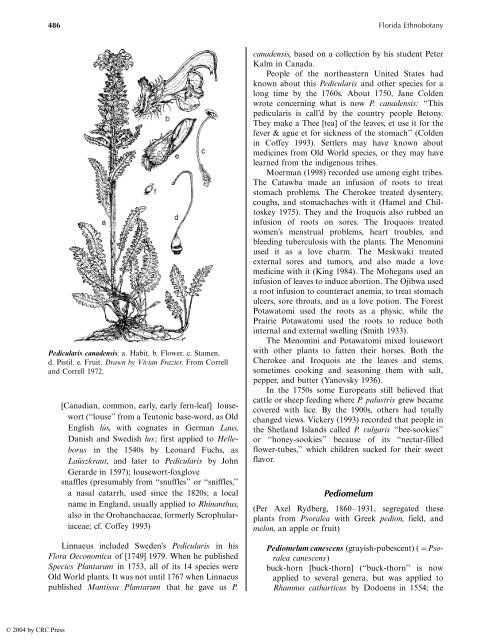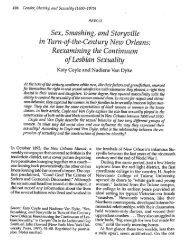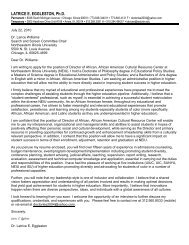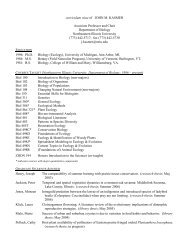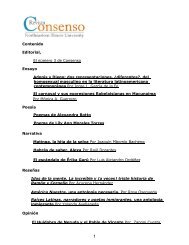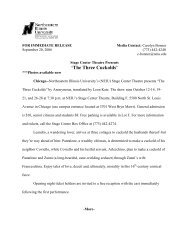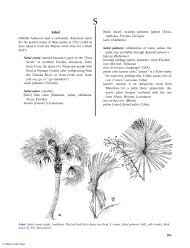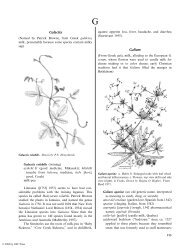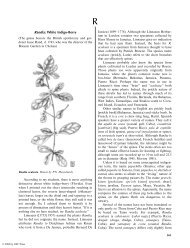Herba Cana - Northeastern Illinois University
Herba Cana - Northeastern Illinois University
Herba Cana - Northeastern Illinois University
You also want an ePaper? Increase the reach of your titles
YUMPU automatically turns print PDFs into web optimized ePapers that Google loves.
© 2004 by CRC Press<br />
486 Florida Ethnobotany<br />
Pedicularis canadensis. a. Habit. b. Flower. c. Stamen.<br />
d. Pistil. e. Fruit. Drawn by Vivian Frazier. From Correll<br />
and Correll 1972.<br />
[<strong>Cana</strong>dian, common, early, early fern-leaf] lousewort<br />
(‘‘louse’’ from a Teutonic base-word, as Old<br />
English lús, with cognates in German Laus,<br />
Danish and Swedish lus; first applied to Helleborus<br />
in the 1540s by Leonard Fuchs, as<br />
Laüszkraut, and later to Pedicularis by John<br />
Gerarde in 1597); lousewort-foxglove<br />
snaffles (presumably from ‘‘snuffles’’ or ‘‘sniffles,’’<br />
a nasal catarrh, used since the 1820s; a local<br />
name in England, usually applied to Rhinanthus,<br />
also in the Orobanchaceae, formerly Scrophulariaceae;<br />
cf. Coffey 1993)<br />
Linnaeus included Sweden’s Pedicularis in his<br />
Flora Oeconomica of [1749] 1979. When he published<br />
Species Plantarum in 1753, all of its 14 species were<br />
Old World plants. It was not until 1767 when Linnaeus<br />
published Mantissa Plantarum that he gave us P.<br />
canadensis, based on a collection by his student Peter<br />
Kalm in <strong>Cana</strong>da.<br />
People of the northeastern United States had<br />
known about this Pedicularis and other species for a<br />
long time by the 1760s. About 1750, Jane Colden<br />
wrote concerning what is now P. canadensis: ‘‘This<br />
pedicularis is call’d by the country people Betony.<br />
They make a Thee [tea] of the leaves, et use it for the<br />
fever & ague et for sickness of the stomach’’ (Colden<br />
in Coffey 1993). Settlers may have known about<br />
medicines from Old World species, or they may have<br />
learned from the indigenous tribes.<br />
Moerman (1998) recorded use among eight tribes.<br />
The Catawba made an infusion of roots to treat<br />
stomach problems. The Cherokee treated dysentery,<br />
coughs, and stomachaches with it (Hamel and Chiltoskey<br />
1975). They and the Iroquois also rubbed an<br />
infusion of roots on sores. The Iroquois treated<br />
women’s menstrual problems, heart troubles, and<br />
bleeding tuberculosis with the plants. The Menomini<br />
used it as a love charm. The Meskwaki treated<br />
external sores and tumors, and also made a love<br />
medicine with it (King 1984). The Mohegans used an<br />
infusion of leaves to induce abortion. The Ojibwa used<br />
a root infusion to counteract anemia, to treat stomach<br />
ulcers, sore throats, and as a love potion. The Forest<br />
Potawatomi used the roots as a physic, while the<br />
Prairie Potawatomi used the roots to reduce both<br />
internal and external swelling (Smith 1933).<br />
The Menomini and Potawatomi mixed lousewort<br />
with other plants to fatten their horses. Both the<br />
Cherokee and Iroquois ate the leaves and stems,<br />
sometimes cooking and seasoning them with salt,<br />
pepper, and butter (Yanovsky 1936).<br />
In the 1750s some Europeans still believed that<br />
cattle or sheep feeding where P. palustris grew became<br />
covered with lice. By the 1900s, others had totally<br />
changed views. Vickery (1993) recorded that people in<br />
the Shetland Islands called P. vulgaris ‘‘bee-sookies’’<br />
or ‘‘honey-sookies’’ because of its ‘‘nectar-filled<br />
flower-tubes,’’ which children sucked for their sweet<br />
flavor.<br />
Pediomelum<br />
(Per Axel Rydberg, 1860 /1931, segregated these<br />
plants from Psoralea with Greek pedion, field, and<br />
melon, an apple or fruit)<br />
Pediomelum canescens (grayish-pubescent) ( /Psoralea<br />
canescens)<br />
buck-horn [buck-thorn] (‘‘buck-thorn’’ is now<br />
applied to several genera, but was applied to<br />
Rhamnus catharticus by Dodoens in 1554; the


